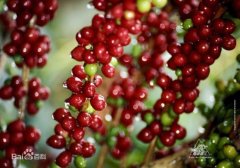Brazilian Coffee Dateira Coffee Manor American flavor
Brazil is the largest coffee producer in the world.
Although Brazil has failed to increase production in recent years, it has greatly improved the quality of coffee in the past decade, trying to get rid of the idea that Brazilian weight is not important to quality and that Brazilian beans are as light as water. In recent years, it has successfully entered the boutique coffee market.
Who says Brazil doesn't have good beans!
The rating of producing areas in Brazil
Compared with the elevations of the producing countries in Central and South America, Brazil is significantly lower, with more estates below 1000 meters than above. The landform here is flat and monotonous, lack of microclimate, and accustomed to unshaded trees (sun-exposed) planting, resulting in the development of Brazil's unique soft bean flavor-low sour taste, heavy nutty flavor, good chocolate sweetness and mellowness, but slightly woody, flower and orange fragrance is not obvious. To put it simply, Brazilian coffee is light, and it is not easy to drink the wild and domineering aroma of sour and orange.
Brazilian coffee interprets soft bean aesthetics in five levels, in the following order: extremely supple (Strictly Soft) → supple (Soft) → slightly supple (Softish) → unpalatable (Hardish) → iodine choking (Rioy).
In other words, Brazilian beans do not emphasize the lively, sour, rhythmic and transparent characteristics of hard beans, but focus on the mild, smooth, mellow and sweet characteristics of soft beans, so Brazilian beans are more suitable for espresso.
Brazilian coffee farms choose sun, half-sun or water washing treatments according to the dry and humidity conditions of the climate to show the best regional flavor. Such a pluralistic approach is rare in the world.
So should it be washed in the sun, half-sun or water? This depends on local temperature conditions, as it can seriously affect whether pods (sheepskin beans) are overfermented and moldy during drying. Local estates will consider to use the best way to reduce the breeding of mold to deal with coffee beans. In principle, the washing method should be used in the areas with high humidity, and the sun or half-sun should be used in the areas with low humidity.
A fiery coffee manor
The best interpreter of soft bean aesthetics-Datera
After 20 years of research and development and cultivation, Daterra Farm, Brazil's national treasure, gives full play to the aesthetics of Brazilian soft beans. Denmark's barista Troels Paulsen won the second ○○ five World Cup barista contest (World barista champion) with the espresso formula of "Datela Sweet Confluence" (Daterra Sweet Collection). Two ○○ six Klaus Thomsen also won the second ○○ six-year World Cup barista contest based on the "Datela Sweet Confluence" with Costa Rica's La Minita coffee. Since then, "Datera" formula beans have immediately become a new favorite of boutique coffee.
The super sweet square bean of "Datera Sweet Confluence", including the four heavenly kings of Dateira, namely, wampee bourbon, wampee Kaduai, New World, and Ikatu 3282, is mixed with sun and half-sun in a certain proportion. After the raw beans are proportioned, they are immediately packed into vacuum-packed tin foil to block oxygen and moisture, so as to prevent the fragrance of raw beans from aging or loss. This practice is more exquisite than putting raw beans into sacks.
Summary
Over the past two decades, Brazil has used high technology to improve the quality of coffee, which has obviously washed away the notoriety of weight over quality, and injected new blood and creativity into boutique coffee. Brazil has long been famous for producing rotten beans, and it will play an important role in fine coffee in the future.
Han Huaizong's "Coffee Studies"
Important Notice :
前街咖啡 FrontStreet Coffee has moved to new addredd:
FrontStreet Coffee Address: 315,Donghua East Road,GuangZhou
Tel:020 38364473
- Prev

The flavor of Colombian coffee beans. Central and South American coffee.
The unique flavor of Colombian coffee has a silky taste. Colombian coffee is equated with high quality and good taste. It is sweet in acid, low in bitterness, rich in nutrition, with a unique sour and mellow taste, and the sour, bitter and sweet flavors of Colombian super coffee match well. Unique fragrance, after drinking, the aroma fills the whole mouth. Handle mouth
- Next

The world's major coffee producing areas introduce the basic knowledge of fine coffee coffee beans represented by all continents
Coffee comes from coffee beans, which are harvested and processed from the fruit of trees. Coffee trees grow at the center of the equator, between latitudes of 25 degrees south and north, and are called the homes of tropical or subtropical countries called coffee belts. At present, there are about 60 coffee-producing countries. Coffee is produced in South America, Central America, the West Indies, Asia, Africa, Arabia, the South Pacific and
Related
- Does Rose Summer choose Blue, Green or Red? Detailed explanation of Rose Summer Coffee plots and Classification in Panamanian Jade Manor
- What is the difference between the origin, producing area, processing plant, cooperative and manor of coffee beans?
- How fine does the espresso powder fit? how to grind the espresso?
- Sca coffee roasting degree color card coffee roasting degree 8 roasting color values what do you mean?
- The practice of lattes: how to make lattes at home
- Introduction to Indonesian Fine Coffee beans-- Java Coffee producing area of Indonesian Arabica Coffee
- How much will the flavor of light and medium roasted rose summer be expressed? What baking level is rose summer suitable for?
- Introduction to the characteristics of washing, sun-drying or wet-planing coffee commonly used in Mantenin, Indonesia
- Price characteristics of Arabica Coffee Bean Starbucks introduction to Manning Coffee Bean Taste producing area Variety Manor
- What is the authentic Yega flavor? What are the flavor characteristics of the really excellent Yejasuffi coffee beans?

